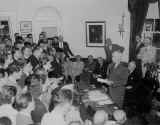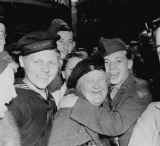1945
|
1945 A $6,228 Federal Works Agency program was approved to provide child care facilities at Redstone Park to take care of employees' children. Long sought by Redstone Arsenal, this nursery was expected to reduce absenteeism and turnover as well as release some mothers for employment. However, the nursery school never materialized because there were not enough mothers employed at Redstone after V-J Day (2 September 1945) to justify operation of the school. 1945 During this period, a great many changes were made in Redstone Arsenal's production schedule. These changes were caused by one or more of the following: anticipation of Victory-Europe (V-E) Day; reductions because of V-E Day; and changes in requirements because of the transfer of operations from the European to the Pacific theater of war. |
|
January 1945 The highest average personnel strength for any one month at Redstone Arsenal during WWII was 4,400. January 1945 The Fred Project, the complex's first contact with the rocket business and the first government in-house liquid propulsion program, was established at Huntsville Arsenal. It was terminated in September 1945, after the system's feasibility had been demonstrated in July 1945. Also two JB-2 flying bombs (similar to the German V-1 bomb) had been launched at Eglin Field, Florida, in August 1945. 16 January 1945 When it became apparent that further expansion of plant facilities would be required for the increased production of artillery ammunition, the War Department approved a $3 million expansion program at Redstone Arsenal. Construction on the new facilities began in February 1945 on land ceded by Huntsville Arsenal immediately south of Redstone's original boundary line. The Tennessee River became the new boundary line for the south side of the Ordnance installation's reservation. March 1945 The Civil Service Commission announced that Redstone Arsenal was leading all other War or Navy Department installations in the State of Alabama in the utilization of physically handicapped persons. Such employees were found to have a very low absentee and turnover rate, while being equal in efficiency in suitable jobs. 20 March 1945 Redstone Arsenal took over 475 acres of land in the southeast corner of the Huntsville Arsenal reservation to accommodate its expansion program. April 1945 Huntsville Arsenal produced about 10,000 E-18 canisters during this month. The E-18 canister was essentially an M-18 colored smoke grenade designed for an Air Corps experimental bomb. Eight such canisters were assembled in a single bomb, presumably to be used as an aerial smoke marker for bombing missions. 1 April 1945 The Chemical Warfare Service increased the Gulf Chemical Warfare Depot's mission by directing the installation to receive, store, and issue gas mask spare parts. It assumed this mission from the Indianapolis Chemical Warfare Depot. |
|
June 1945 The first reduction-in-force (RIF) was implemented at Redstone Arsenal. 3 June 1945 In accordance with War Department guidance, Redstone Arsenal implemented a tobacco rationing system to control the sale of tobacco to authorized personnel. 23 June 1945 The Report of the Board on Permanent Construction at Installations Chosen for Postwar Retention was issued on this date. The Spraker Board, as this body was more commonly known, recommended that the mission of Huntsville Arsenal in postwar planning be "primary production of smoke materiel and emergency production of chemical agents." A portion of this report also covered the establishment of the CWS school in the northern portion of the installation's reservation as well as the creation of a proving ground area which would enable "all CWS munitions and chemically filled Ordnance munitions to be tested as developed and manufactured." Other changes proposed by the Spraker Board included estimates for the expenditure of $17,580,650 at Huntsville Arsenal. Fifteen of the proposed projects provided for additional manufacturing facilities either by the relocation of such facilities from other arsenals or industrial organizations, or the purchase or construction of new facilities. The remaining recommendations addressed the improvement of the arsenal's layout to increase the operating efficiency of necessary indirect and overhead activities such as engineering services, the distribution of steam and electricity, establishment of a central classification yard, and the construction of additional warehouses to accommodate the new operations. The report also proposed the building of permanent housing for both military and civilian personnel. July 1945 The pilot stage of the M-77 bomb and E-51 cluster programs began at Huntsville Arsenal, but all development activity on this smoke munition ceased the following month. 25 July 1945 Redstone Arsenal employees received the War Department Citation, signed by the Secretary of War, and the Secretary of War's War Bond flag on this date. Awarded in recognition of the fact that 95 percent or more of the arsenal's employees were investing 15 percent or more of their monthly pay in War Bonds, the citation and flag were the first to be presented to an installation in the Fourth Service Command. 13 August 1945 The Chief of the Chemical Warfare Service instructed the Gulf Chemical Warfare Depot to discontinue processing ammunition for shipment and return such ammunition to stock. Because the depot assumed that it would receive a large quantity of materiel for storage from other locations, no immediate demobilization plans were made. |
|
14 August 1945 The war with Japan ended. |

At the White House, President Harry Truman announces the Japanese Surrender. August 14, 1945. (Photo credit: U.S. National Archives) |
|
17 August 1945 Production at Redstone Arsenal ceased, although some lines operated part of the day to complete items already in process. During the last quarter of 1945, there were no items manufactured or assembled at Redstone Arsenal. 20 August 1945 The Chief of the Chemical Warfare Service issued instructions to put certain Huntsville Arsenal plants in "standby storage" and others in "standby under power." This policy was changed on 11 September 1945 to place all plants in standby storage thereby considerably reducing the arsenal's workload. 31 August 1945 Effective this date, bus service to Redstone Arsenal from Decatur, Athens, Guntersville, and Arab, Alabama, was discontinued. 2 September 1945 V-J Day was celebrated. Although it was to continue as a permanent manufacturing arsenal of the Ordnance Department, Redstone's activities were greatly curtailed. The renovation and salvage of ammunition returned from overseas continued as planned. After this date, all employees not needed were placed on annual leave pending the announcement of Redstone Arsenal's work program. Steps to effect a general RIF were implemented. When completed, this process would reduce the installation's civilian strength from 3048 at the start of the second quarter to about 600 employees. 2 September 1945 The mechanization and expansion programs started by Redstone in August 1944 were substantially completed by this time. The scope of these programs was to increase the overall production capacity of the installation and lower the unit cost of the items produced. 1 October 1945 After the inactivation of the Indianapolis Chemical Warfare Depot, the Gulf Chemical Warfare Depot assumed responsibility for the storage and issue of all spare parts for CWS items. The movement of materiel from Indianapolis began on 1 November 1945. 13 October 1945 The Office of the Chief, Chemical Warfare Service, authorized the establishment of a gas mask assembly line at Huntsville Arsenal. Building 481 housed the operation, which began in January 1946. 5 November 1945 The M-54 incendiary destruction program was completed. The munitions were burned in an isolated section of Huntsville Arsenal, but the empty wooden boxes were sold to the public as salvage. The extreme shortage of building lumber created a high demand for these boxes. As a result, many postwar houses in the Huntsville area were floored and sheeted with former M-54 boxes. Container sales receipts paid the cost of the M-54 incendiary destruction program. 30 November 1945 The major RIF and primary readjustment of Redstone Arsenal activities to a peacetime basis was accomplished. |
The Pre-Missile Era:
Introduction,
1941
,
1942
,
1943
,
1944
,
1945
,
1946 & 1947
,
1948 & 1949


